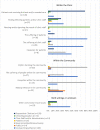Moral distress among clinicians working in US safety net practices during the COVID-19 pandemic: a mixed methods study
- PMID: 36008061
- PMCID: PMC9421917
- DOI: 10.1136/bmjopen-2022-061369
Moral distress among clinicians working in US safety net practices during the COVID-19 pandemic: a mixed methods study
Abstract
Objective: To explore the causes and levels of moral distress experienced by clinicians caring for the low-income patients of safety net practices in the USA during the COVID-19 pandemic.
Design: Cross-sectional survey in late 2020, employing quantitative and qualitative analyses.
Setting: Safety net practices in 20 US states.
Participants: 2073 survey respondents (45.8% response rate) in primary care, dental and behavioural health disciplines working in safety net practices and participating in state and national education loan repayment programmes.
Measures: Ordinally scaled degree of moral distress experienced during the pandemic, and open-ended response descriptions of issues that caused most moral distress.
Results: Weighted to reflect all surveyed clinicians, 28.4% reported no moral distress related to work during the pandemic, 44.8% reported 'mild' or 'uncomfortable' levels and 26.8% characterised their moral distress as 'distressing', 'intense' or 'worst possible'. The most frequently described types of morally distressing issues encountered were patients not being able to receive the best or needed care, and patients and staff risking infection in the office. Abuse of clinic staff, suffering of patients, suffering of staff and inequities for patients were also morally distressing, as were politics, inequities and injustices within the community. Clinicians who reported instances of inequities for patients and communities and the abuse of staff were more likely to report higher levels of moral distress.
Conclusions: During the pandemic's first 9 months, moral distress was common among these clinicians working in US safety net practices. But for only one-quarter was this significantly distressing. As reported for hospital-based clinicians during the pandemic, this study's clinicians in safety net practices were often morally distressed by being unable to provide optimal care to patients. New to the literature is clinicians' moral distress from witnessing inequities and other injustices for their patients and communities.
Keywords: Human resource management; MEDICAL ETHICS; PRIMARY CARE; QUALITATIVE RESEARCH.
© Author(s) (or their employer(s)) 2022. Re-use permitted under CC BY-NC. No commercial re-use. See rights and permissions. Published by BMJ.
Conflict of interest statement
Competing interests: TER and JNH work in public agencies that operate or are affiliated with loan repayment programs whose clinicians are included in this study. Other authors declared no potential conflicts of interest with respect to the research, authorship and/or publication of this article.
Figures


References
-
- Taylor A. Photos: the reality of the current coronavirus surge, 2020. The Atlantic. Available: https://www.theatlantic.com/photo/2020/12/photos-reality-current-coronav... [Accessed 17 Nov 2021].
-
- Stockton A, Death KL. through a nurse’s eyes. Opinion. New York Times 2021.
Publication types
MeSH terms
Grants and funding
LinkOut - more resources
Full Text Sources
Medical
Research Materials
